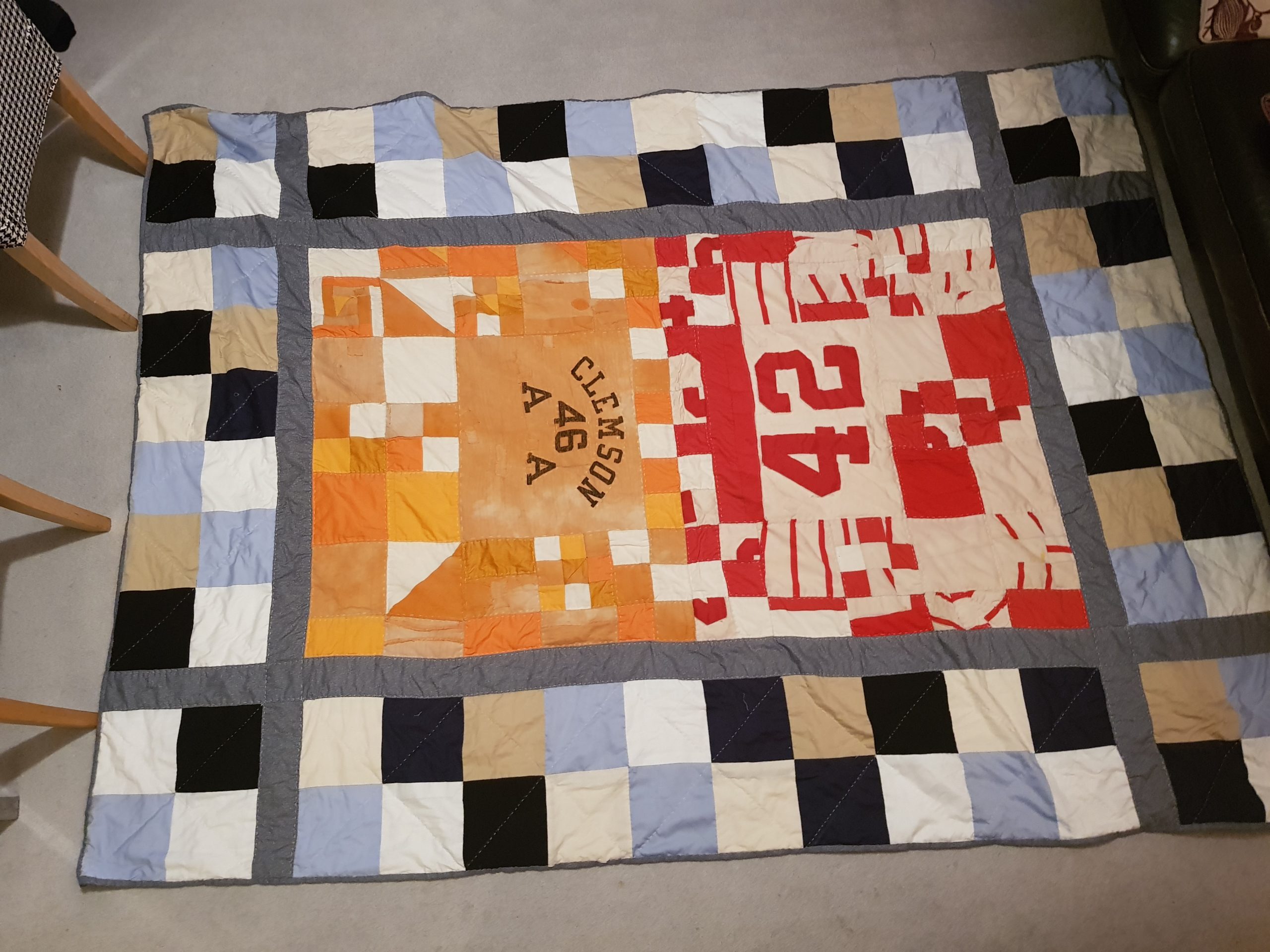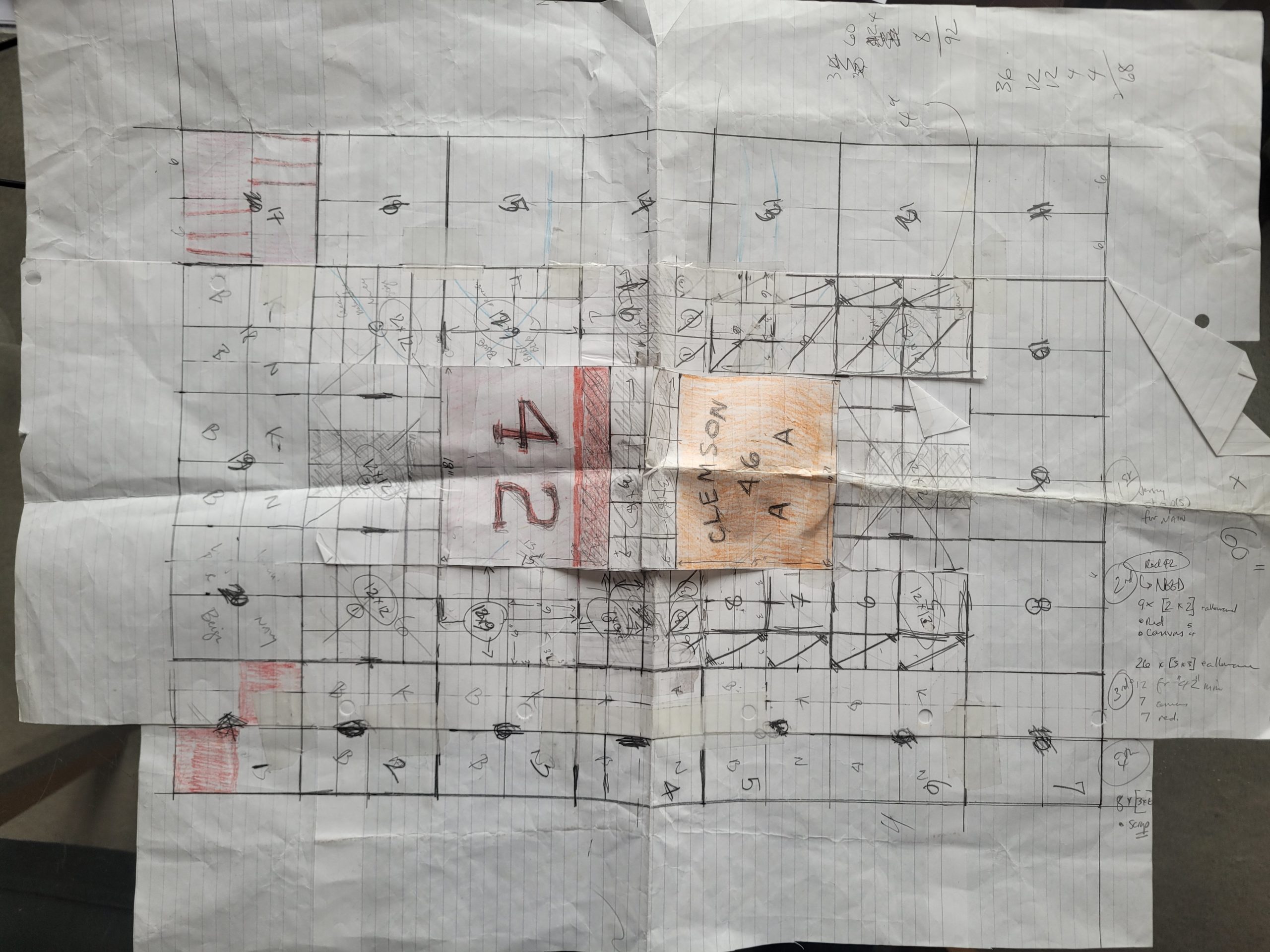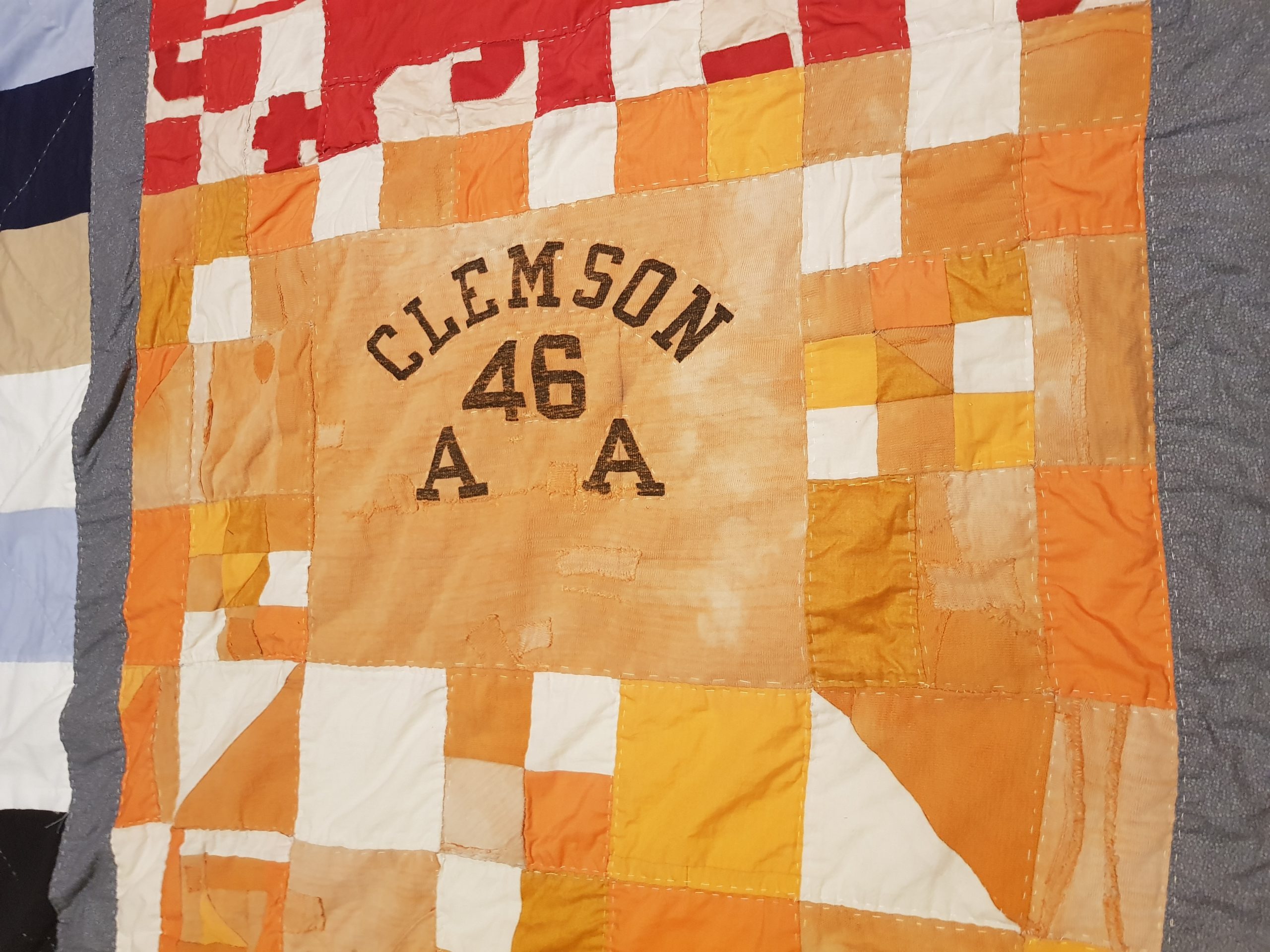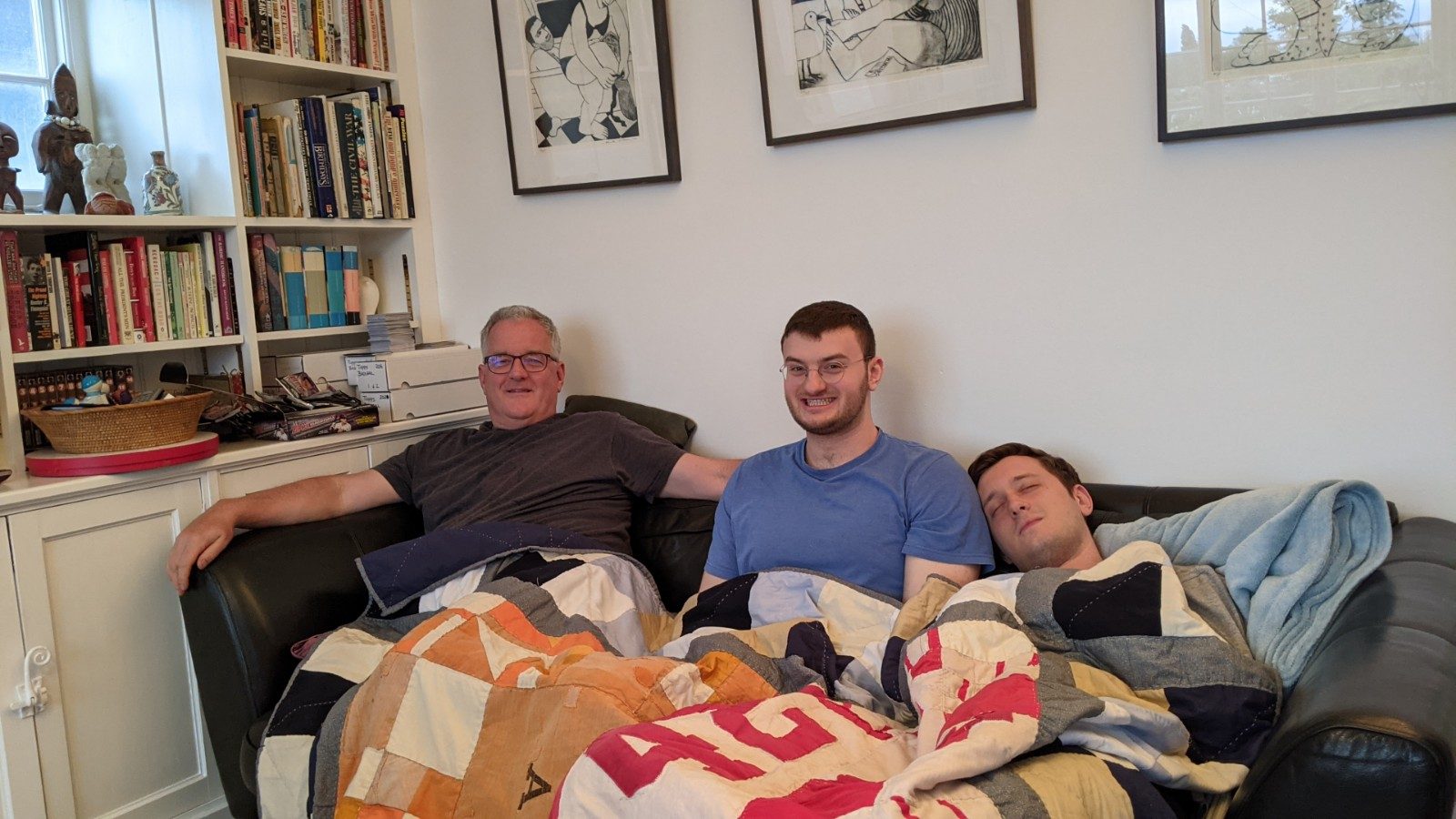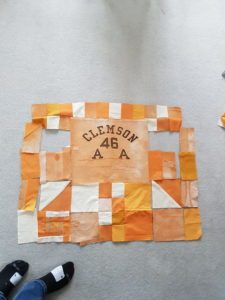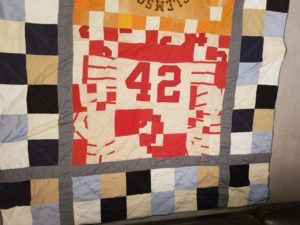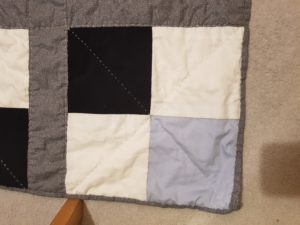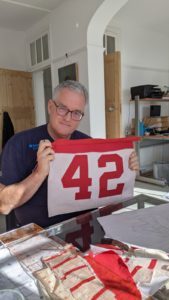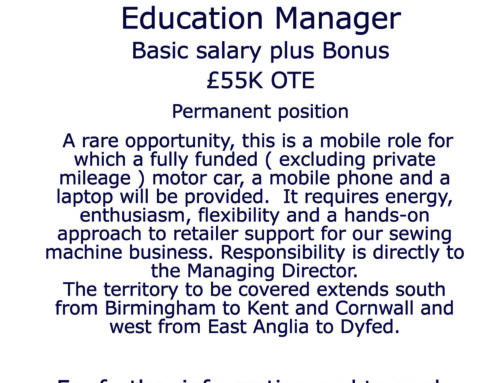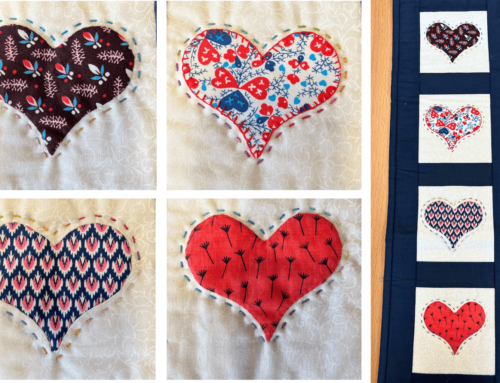I had been thinking about making a quilt since joining justhands-on.tv as the CEO in 2017. For two reasons:
- I was inspired by all the videos I was watching.
- As CEO of justhands-on.tv I felt like an imposter not having made a quilt
But I needed a spark.
In 2019, the year after my father passed away, I was going through boxes of my old stuff and came across 2 old American football jerseys of his.
- Clemson University practice jersey
- York Red Roses semi pro game jersey (hooped sleaves)
He had given these jerseys to me when I was around 8 years old. I wore them everywhere. Played football in them. Ran around University in them. Repaired them, sometime with patches of old socks.
These jerseys were deteriorating. Literally. But I couldn’t throw them out. So I threw them in a trunk and carried them around with me from Cleveland to New York and then London. Coming across these jerseys was the spark I needed. I decided to use the fabric from the jerseys to make a memory quilt.
Just before I launch into the trials and tribulations of my first quilt, I’d like to share with you my starting point as a quilter.
I was not a quilter when I started. More of a sewer. And a hand sewer at that.
When I was a kid, I had very bad allergy attacks during the summer. There were no antihistamines readily available. So, I had to come inside, throw a wet towel on my face, and wait for the allergic reaction to subside. I turned to sewing to fill the time. Sewing patches on my jean jacket.
My mother was an avid crafter – – mostly knitting. There was always crafting stuff around the house. So, I come by my interest in crafting honestly.
Importantly, I do not have sewing machine.
With that background, I set off on my first quilt journey.
The first thing I did was to draw out a design. I focussed on the centre piece to start. I have observed that some quilters like to build their quilts in rows. Others, such as my colleague, Anita Birtles, like to build up their quilts in columns. For whatever reason, I built out from the centre. Very focussed on how I would manage the centre piece with the two jerseys. The design grew and grew and grew. You can tell by all the extra pieces of paper that were attached how it grew.
Then, I enlisted the support of one of the world’s greatest tutors: Valerie Nesbitt. I need to give a big shout out to Valerie. She was incredibly patient and encouraging. Generous with her time and advice.
I remember her saying:
“Heritage fabric is a challenging fabric to use for a first quilt but if it inspires you to carry on then that’s great.”
“Remember to STABILISE. Heritage fabric wants to be stabilised.”
I loved the personification of heritage fabric and how it loved nothing more than some stabilising.
And with a note of caution, “Heritage fabric is precious so be careful before you start cutting.”
She added two more general quilting pieces of advice:
“Don’t forget your ¼ inch seam allowance.”
“There are no mistakes. Have fun. Enjoy the journey.”
What did I do?
I stabilised the fabric (badly). Gummed up an iron. Then I jumped straight into cutting the heritage fabric with my new rotary cutter. Getting my ¼ inch seam allowance wrong!
I found this very frustrating. I could not work out why I was having such a problem with the ¼ inch seam allowance. I’m relatively good at math. I promise. Thankfully, I didn’t ruin too much of the jersey fabric before I got my head around it.
Valerie’s advice kept ringing in my head: “There are no mistakes. Have fun. Enjoy the journey.”
And I did have great fun creating different patchwork designs with the scraps that I had. You can see sampler blocks and examples of crazy patchwork in places.
One of my favourite bits is the random 42 pieces row. There was a large 42 on the back of the jersey (used for the middle of the quilt) and a smaller 42 from the front of the jersey. I cut up the front/smaller 42 into 3 inch squares then assembled them in a slightly random way. This made them seem like relics. When assembled, it reminded me of that sliding puzzle game we played as children where you’d move tiles around with the square to reveal a picture.
Then, covid hit.
This was a game changer. I had large chunks of time that I could dedicate to making my quilt. My quilting ambition grew to fill the time. I now wanted a full bed quilt. And I started getting more serious about how all of my blocks would come together.
However, I was running out of heritage fabric.
This pushed my design thinking. I added an outer section finding fabrics that echoed the colours that my father used to wear: white, beige and navy blue. You know that story about Einstein? How he had 7 identical suits, one for every day of the week, because he didn’t want to waste time thinking about what to wear. My father was an engineering version of that. White, Beige and Navy Blue because he knew those colours worked for him and didn’t want to waste time thinking about other colour combinations.
I bought most of the fabrics that I was now adding to my design. It made me a little sad to remember throwing away so many clothes while clearing out my father’s place. I wish I had saved a bunch of his clothes in a bag for a later date.
Now I know.
More drawing. More cutting, More patchwork. More sewing. All working out from the centre. Block by block. All the while, checking in with Valerie for thoughts on the design. She made some great suggestions, e.g. grey strip.
Finally, I finished the quilt top.
This brings me on to Layering, Quilting, and Binding. Time and my mental health prevent me from detailing what I went through with the quilting. What I will say is this:
- I picked a navy blue bed sheet for the backing. Happy with that. Very simple. And created a nice, Sashiko-like effect with the white thread. However, it also amplifies the bad quilting stitches. There are a lot of bad quilting stitches.
- Pins, pins, pins. I can’t believe how many pins I had to use to sandwich everything together. I learned later that there are large hoops that can help with this. That would have helped. Note for the future.
- The ladder stitch. How amazing is the ladder stitch on the edges! I watched a justhands-on.tv video on how to do this (click here if you’d like to see it). It didn’t prepare me for the elation that comes with pulling the thread and having all the sewing disappear. Magic.
I am not in a rush to hand quilt such a large quilt again. But it was worth it. I love my quilt. We use it as a very large snuggle on our sofa. Here’s a picture of the quilt, sofa, and me with my two boys.
Did it make sense to make a very large, hand sewn memory quilt featuring heritage fabric as my first quilt?
Probably not. But this made it more interesting and motivating for me.
Will I make a 2nd quilt?
Absolutely YES. I loved making this quilt.
Will I hand sew again?
Almost certainly yes. I love the feeling of sewing by hand. I also find it very calming. Very Zen.
For the record, I have done some machine sewing. At one of the justhands-on.tv retreats, in fact. I can see how machine quilting allows you to do more exciting design work, faster. That’s wonderful. But I also felt that the machine sort of ran away from me. If that makes sense. Not saying never. And I do have my eye on one of those mid-range Janome machines.
At the moment, I am searching for design inspiration for my next quilt. Looking forward to Festival of Quilt for ideas. Also happy to take on board any suggestions that any of you might have.
Steve Barton
CEO, justhands-on.tv

